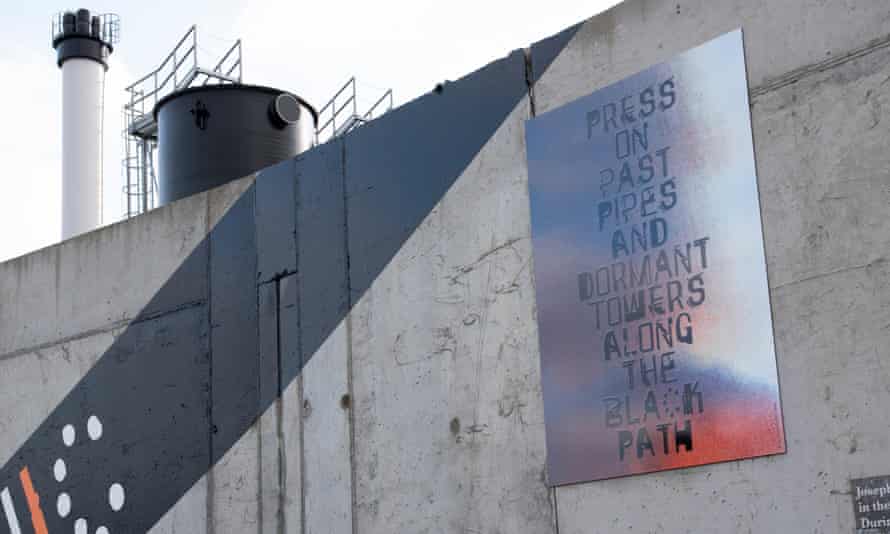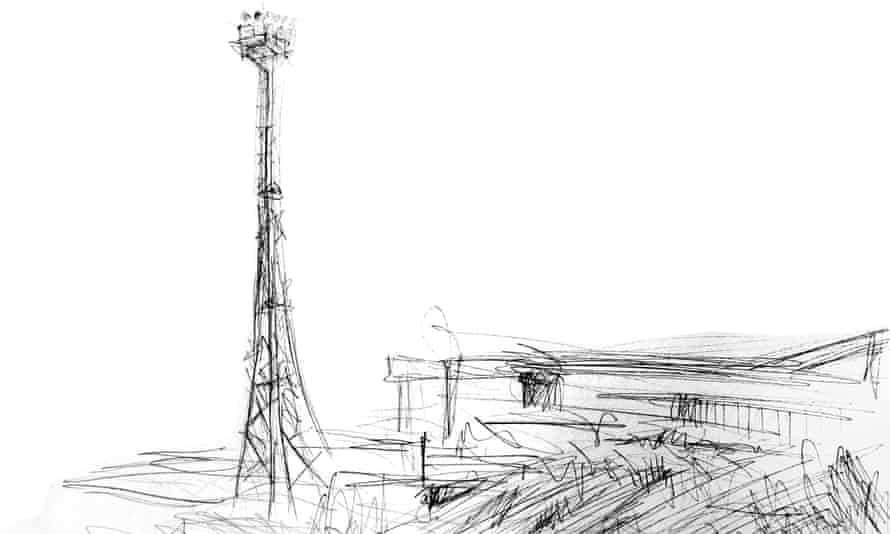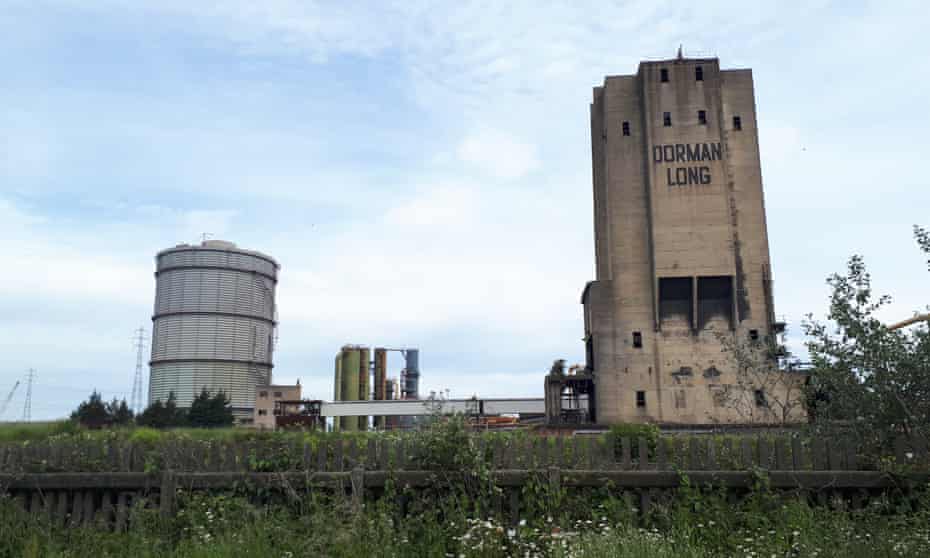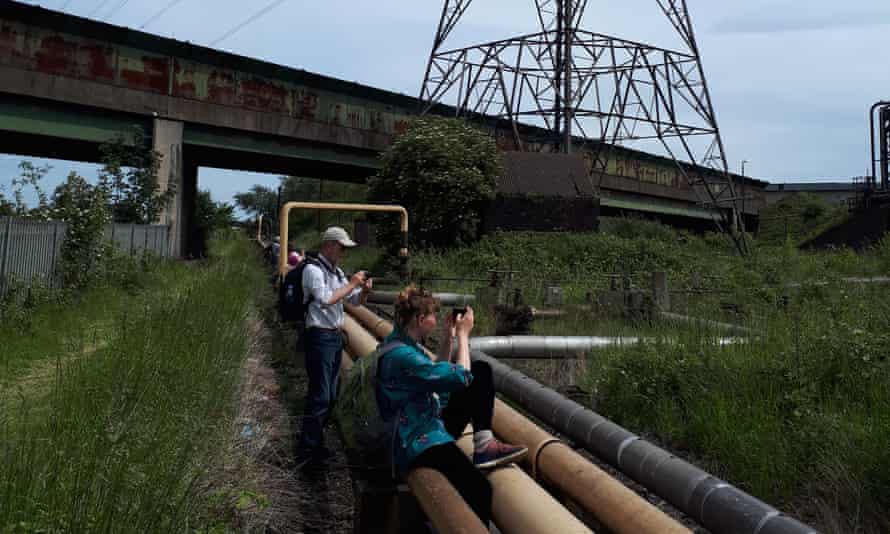On a slow June Sunday back in 2019, I walked the historic Black Path route, from Middlesbrough to Redcar, through the heart of industrial Teesside. I was part of a “sketch-crawl” organised by Black Path Press, a community book publishing project in the South Bank district of Middlesbrough. Artist Philip Boville had been invited along to offer insights into industrial locations along the way. The walk was coordinated with River Tees Rediscovered and Groundwork, whose expert guidance opened up a part of my local area I might never have discovered. I packed a rucksack with sketchbook, pens, pencils and a picnic, and made my way to South Bank station, a half-hour walk from the start of the path, behind the Navigation Inn in Middlesbrough.
Adam Phillips and Deborah Bower from Black Path Press had heard conflicting stories about where the path’s starting point might be, but felt the station was the easiest access point for visitors. As Adam pointed out, the southern side of the stunning Transporter Bridge, by the River Tees, would make a dramatic entry point for those unfamiliar with the area. Perhaps one of the reasons for this uncertainty is that the path itself fluctuates from patchy Tarmac to worn “desire paths” through the grass, even veering off on to the Trunk Road, a mundane dual carriageway, for half a mile or so. Grimy steel slag, a byproduct of steelmaking, was used for the foundations for the path, and, combined with the accumulation of industrial cinders underfoot, helped give it its name. The slag has helped to fertilise the earth around the path, allowing the pink-bloomed crown vetch, native to the Mediterranean, to thrive in this unlikely environment.

At South Bank station, there’s a skeletal iron footbridge over the train tracks. Generations of steel and ironworkers have clanked across this bridge at the start and close of each day, and trains continue to rush by on the line beside a long stretch of the path. Before the steelworkers, the Black Path was used by sailors to reach their ships at the ports of Coatham, Dabholm, Cargo Fleet and Newport; in those days the path was known as the Sailor’s Trod. Families also used the route to escape the South Bank terraces and walk to the beach at Redcar. Earlier still, it is said that English rebels camped here during the Norman conquest, trying to outrun William the Conqueror and his army. Today, the crowds have been replaced by the occasional dog walker or rambler on what is also the last leg of the Teesdale Way, signalled by a metal sign near the station entrance.
The further away from the station we got, the more isolated it felt. Wildflowers sprouted in all directions, and the occasional lichen-covered pipe stuck out its long limb from the empty fields behind the fence. Once, these pipes carried gas and oil to the steelworks, and you can still see “oxygen” or “blastfurnace gas” stencilled on them in block capitals. Overhead wires make the air tingle above tangled brambles.

The Dorman Long steelworks tower has lain dormant for many years; its imposing, concrete coal bunker, emblazoned with the company name, is a brutalist obelisk – its stained, beige husk a reminder of enterprise and entropy of lives that were productive yet tough. For visitors who only want a short walk, it lies close to the station, visible in all weathers.
Beyond the ever more complex network of pipes that begin to crisscross the Black Path lies the Teesport Container Terminal. Steps lead up to a bridge, allowing an excellent view of the thriving import and export interchange in all its complex glory. Aside from the countless cranes on the horizon, there’s a lot to take in, and I’d like to return and make some visual notes on this particular spot. It feels like there’s less time to capture the older industry before it disappears from view, which is what we concentrated on for our sketch stops.

About a quarter of the way through my sketch-crawl, the path narrowed and my unsuitable footwear sank in a marshy quagmire. The wall that borders this section of the Black Path had, at that time (in 2019), ghostly impressions of various waterbirds painted on to the brickwork some time ago, faded like a colourful transfer on a child’s forearm. These paintings have since been renewed, and the Teesside Archives website reveals that they were “created by Joe Parkes, who worked in the shunting yard at Lackenby from 1976 to 1985. Joe would occupy any spare time during shifts making art that would eventually be seen by tens of thousands of people on their daily commutes … He even got a round of applause one day when the train broke down opposite his painting wall.” The Black Path has captured the imagination of other creative people in the area too, each fascinated with the history and the way nature rubs shoulders with industry.
At art college, I was drawn to the shapes and unusual juxtapositions found in industrial landscapes, making sketches and oil paintings of my local area. Artists like Len Tabner, who collaborated with photographer Ian Macdonald on the book Images Of The Tees, were great examples for Teesside art students like myself. Indeed, artist Phillip Boville, who led the walk that day, had contributed to the artistic life of the region with his large-scale 1975 Teesside Steel Mural, seen by thousands of visitors to the Lackenby medical centre over a 40-year period. After our walk, Black Path Press created a vibrant artwork, Notes On The Black Path, featuring nearly 50 bespoke poster designs (including one with new words by me) all laid around a lyric by the South Bank-born songwriter Vin Garbutt. Also in 2019, The Secret Gallery appeared on a footbridge, with artwork by 10 local artists, organised by South Bank’s Saabat Gallery.

Since that sunny June day, I’ve been back to the path, in light autumn drizzle, to film portions of the video for Maxïmo Park’s Child Of The Flatlands. I found myself inspired to write about the “edgelands” exemplified by the Black Path, and by the old ICI works that pepper the uniform fields at the eastern fringe of my home town of Billingham in County Durham. As the song tells it: “Industrial turrets were our fairytale castles,” and, in a spacious musical clearing in the middle of the song, I sing “Nature always wins”, which ended up being Maxïmo Park’s new album title. It felt pertinent to these neglected areas where urban meets country, and nature reclaims its native territory. It felt like this phrase could apply to a lot of the other personal themes on the record – about parenthood, or coming to terms with your past.
In many ways, as someone who has moved away – I remained in my university city of Newcastle upon Tyne – I’m forced to confront my youth and personal history when I return to Teesside. Throughout my Black Path walk, I thought about the industrial heritage of the region, imagining my own father as an apprentice welder on the shipyards, moving on to his time at the ICI chemical plant; how we would drive through where he worked, in the dark, returning from a family camping holiday, dazzled by the lattice of lights attached to various angled pipes and tall chimneys. Famously, this was the landscape that inspired Ridley Scott’s Blade Runner, and Aldous Huxley’s Brave New World, lasting artistic testaments to its frequently maligned qualities. The billowing steam released from gigantic, hyperboloid cooling towers remains a striking feature of the skyline. These, along with the smoking chimneys, are why we Teessiders are often referred to as Smoggies!

On my original walk, we eventually emerged from the long grass of Coatham Marsh and ascended a hill adjoining the hamlet of Warrenby. We found ourselves overlooking a unique vista of long metal chutes leading to fading warehouses. At the centre of it all were the tangled, outstretched arms of the disused Redcar Steelworks’ blastfurnace, and behind us was the North Sea in all its glory – the contrasting visual elements stirring up a mixture of emotions, never mind the layers of memory embedded within the route.
Which makes these industrial remnants ideal for partial maintenance and care, rather than wholesale regeneration. The local Tory mayor, who has earmarked the old steelworks for demolition, may not agree, nor perhaps would some local people, who associate the works with decline and harsh working conditions rather than the industrial force it once was. However, there’s a continuing local debate about what happens to the site, with a fully costed plan to preserve the Dorman Long tower and Redcar blastfurnace. At the industry’s peak, there were 91 fiery blastfurnaces within a 10-mile radius, and I believe saving the last remaining furnace as a permanent monument to hard graft and enterprise would enrich the landscape for future generations.
My journey culminated in a stroll along Redcar seafront, past the site of the beautiful but now demolished art deco Regent Cinema. Strictly speaking, it’s well beyond the end of the Black Path, but I couldn’t resist a visit to Pacitto’s ice-cream parlour. The business was set up by two Italian brothers who hitchhiked to the north-east from Italy at the turn of the 20th century, originally starting their business in nearby Stockton. A few of my companions joined me in ordering a lemon top – lemon sorbet perched precariously atop a vanilla ice-cream – a local delicacy that reminds me of childhood seaside trips, and a fitting reward for anyone completing the Black Path.
Maxïmo Park’s latest album, Nature Always Wins, is released today on Prolifica Inc




